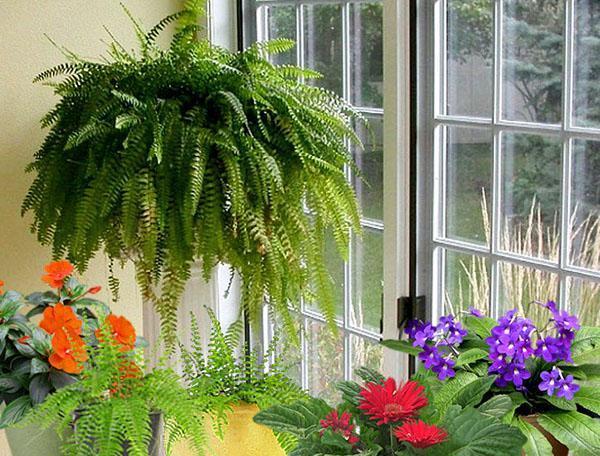Tropical Accent Nephrolepis Care
 Indoor fern is a tropical plant, therefore it does not tolerate direct sunlight. Caring for nephrolepis involves more than just maintaining a humid microclimate. It is necessary to monitor the temperature regime, which should be at least 15 ° С and not higher than 22-25 ° С. Yet he has periods of rest. Then it is advised to take the pot to a cool room (about 12 ° C) and reduce the amount / portion of watering.
Indoor fern is a tropical plant, therefore it does not tolerate direct sunlight. Caring for nephrolepis involves more than just maintaining a humid microclimate. It is necessary to monitor the temperature regime, which should be at least 15 ° С and not higher than 22-25 ° С. Yet he has periods of rest. Then it is advised to take the pot to a cool room (about 12 ° C) and reduce the amount / portion of watering.
Nephrolepis care: lighting, soil and feeding
Whenever possible, they try to create a moist "aura" for him. Of course, some people use special humidifiers to keep their greenhouse healthy. If this is not possible, then the shrubs are sprayed several times every day. Other growers give them a warm shower to refresh the green fronds.
For growing crops, it is not recommended to choose window sills. Otherwise, the flowerpot will lose all its decorative effect, because one part will be constantly deformed from the side of the glass. Suitable for him:
- racks;
- wall structures (bookshelves or hinged sub-vases);
- pots.
Phosphorus-based dressings are not suitable for deciduous varieties, as they are designed to stimulate flowering. Ferns need nitrogen to gain green mass, as well as potassium, which strengthens the root system.
The main requirement in caring for nephrolepis is sufficiently bright lighting, but without hitting the scorching rays of the sun. For seedlings, only acidic soil or a substrate based on non-wine peat are selected. All ornamental-deciduous crops in the growing season are advised to apply nitrogenous fertilizers. Also in the spring and summer, the plant is sent to:
- terrace;
- summer cottage (to the garden);
- balcony.
In winter, nephrolepis are rarely watered and using a pallet, since it is equipped with a powerful root system. Moreover, there are preparations for foliar feeding. She is sprayed with greens only once a month in winter, and also every week for the rest of the time. Components included in it:
- saturate foliage with nutrients;
- stimulate growth;
- increase immunity;
- prevents drying out.
When there are such healthy bushes in the room, the atmosphere becomes the same. It is worth knowing that they also purify the air from dust, carbon dioxide and carbon monoxide.
When do problems arise?
Being in acidic soil for too long, the shrub begins to hurt with chlorosis, because iron is not absorbed. In this state, it is most susceptible to viral and bacterial microorganisms. The first signs are yellowed fronds, which eventually simply fall off. In this case, it is transplanted as soon as possible. Indoor fern often affects:
- spider mite;
- shield;
- whitefly;
- soil pests.
It is recommended to deal with them with acaricidal drugs or improvised means. A tablespoon of ammonia is diluted with 1 liter of water. Then the green mass is carefully sprayed or the soil is shed. These procedures constitute the whole technology of nephrolepis care. Among other things, it must be transplanted on time.